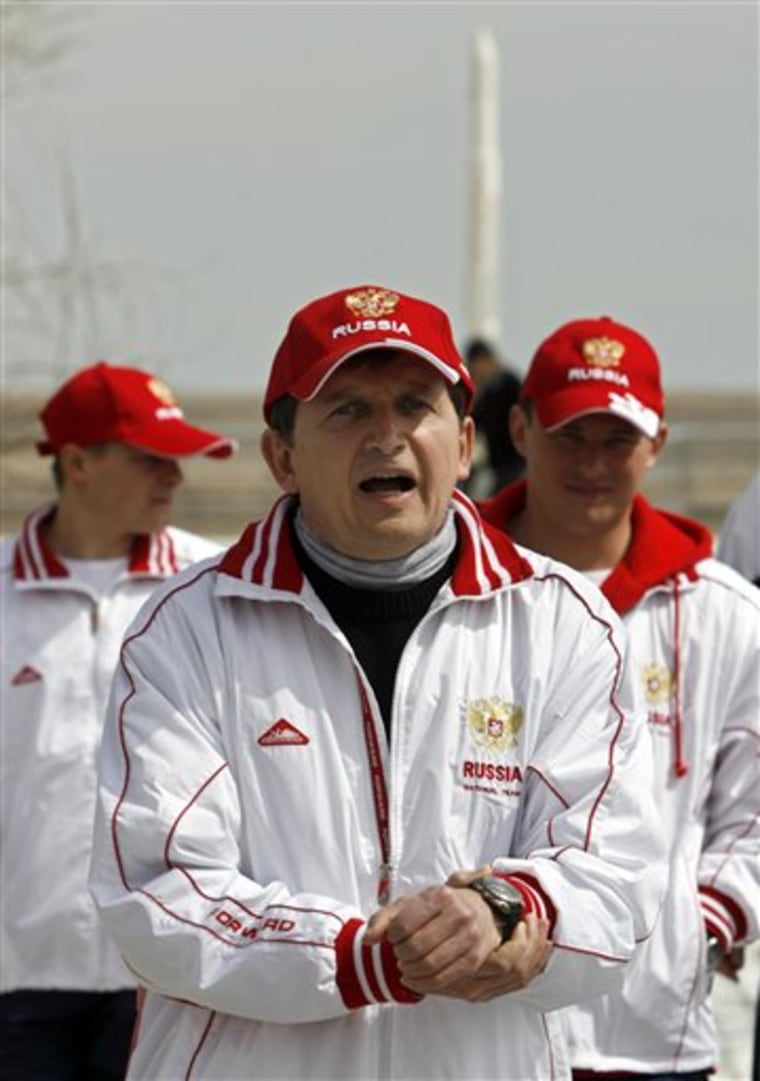In one of their last days before blasting off in a closet-sized capsule, two Russian cosmonauts and a U.S. billionaire computer programmer enjoyed an array of earthly pleasures Wednesday — a springtime stroll, a game of pingpong and a freshly cooked lunch.
Engineers, meanwhile, were finishing the assembly of the Russian-made Soyuz rocket that will be launched Saturday night carrying Fyodor Yurchikhin, Oleg Kotov and Charles Simonyi to the international space station.
As they took a stroll down the so-called Cosmonauts' Alley at the training center in Baikonur, Kazakhstan, Yurchikhin quipped to reporters that he was more worried about saying goodbye to his wife than about the spaceflight.
"Yes, I am very nervous: my wife is coming soon, I have to look nice and shaved." said Yurchikhin, 48. "What launch? Is there going to be a launch?"
Simonyi, who spent $25 million to become the world's fifth paying "space tourist," said he was getting lots of training and assistance.
"Everyone is helping me so much that it's easy," the 58-year-old Hungarian-born computer programmer told reporters.
Simonyi's 13-day journey includes roughly 11 days on the orbiting station and travel time to and from it. He returns to Earth on April 20 along with the two of the station's current crew, Russian cosmonaut Mikhail Tyurin and American astronaut Miguel Lopez-Alegria.
The third member of the current crew, U.S. astronaut Sunita Williams, will remain on board until June, when she will be replaced by Clayton Anderson.
Yurchikhin and Kotov will be aboard the station for more than six months.
Simonyi had earlier said that the hardest parts of training were learning Russian and spinning in a high-speed rotating chair to help train against dizziness. Now, he said he has begun to actually enjoy the chair, and his Russian _ some of which he studied as a child in Hungary _ is improving.
Before sitting down to a three-course lunch, Simonyi began a pingpong game with Yurchikhin with an energetic "Poyekhali," or "Let's go" in Russian — an echo of the words uttered by cosmonaut Yuri Gagarin in 1961 as he blasted off to become the first man in space.
"I think the space station will be more surprising than the Earth," Simonyi said. "The Earth will be there at the start, it's going to be there during the flight, it will be always there, but the space station will somehow come out of nowhere."
Born in Communist Hungary, Simonyi first learned computer programming on a bulky Soviet computer called Ural-2. Later, after emigrating to the United States, he worked for software giant Microsoft Corp.
He said his former colleague — Microsoft CEO Bill Gates — was paying close attention to the adventure and has asked several questions on Simonyi's Web site. Yurchikhin joked that Gates is probably busy training himself to be a "spaceflight participant" — as Simonyi and his four paying predecessors have been known.
Simonyi said he found it fitting that four decades after he learned to program on a Soviet machine, it is the successor of Soviet technology that was sending him into space.
"Technology and engineering, it has very little to do with politics, so I am very proud of my background with my — at that time — Soviet computers," he said.
Simonyi said an Ural-1 computer that he saw at the Baikonur museum reminded him of the Ural-2, on which he learned his craft.
"And I kind of thought, the circle has closed. We are back to the future, I think it's great," he said.
